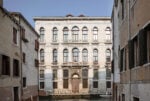Olaf Metzel / Heimo Zobernig
.jpg)
Coniugare le opere di Olaf Metzel e Heimo Zobernig in una mostra consente di compiere una riflessione su quanto il loro lavoro condivide, ma anche su ciò che ampiamente lo distingue.
Comunicato stampa
Coniugare le opere di Olaf Metzel e Heimo Zobernig in una mostra consente di compiere una riflessione su quanto il loro lavoro condivide, ma anche su ciò che ampiamente lo distingue.
La mostra include una serie di lavori monocromi di Heimo Zobernig che creano quasi uno sfondo alle sculture di Olaf Metzel. L’uso del tessuto del Trevira Television CS - supporto per chroma key nelle produzioni cinematografiche - mediante il quale lo sfondo di colore blu, verde e rosso in un’immagine video può essere sostituito da un’altra immagine - è consueto per Zobernig. In questa serie di lavori lo sfondo è concepito per l’ulteriore sfondo - il bianco - bianco inteso anche come muro della galleria che ospita le opere d’arte, offrendo idealmente una situazione neutra di percezione. In alcuni tele l’ultimo strato è trasparente con l’interferenza di colori.
Heimo Zobernig continua a scardinare il linguaggio formale del Modernismo - compromettendo la purezza estetica del monocromo e riportandolo sul piano decorativo, funzionale e ironico.
Zobernig è pragmatico. Le tele sono esattamente quel che dovrebbero essere: oggetti in esposizione. L’inganno della superficie spinge il pubblico a partecipare alla routine comportamentale coordinata dall’artista.
Olaf Metzel crea una sovrapposizione di strati che riflette il tema dell’aggressività come sua personale tecnica scultorea: piega, incurva e deforma le immagini della città, riprodotte su entrambe le facce delle lastre di alluminio, creando così l’irritante illusione di trovarci di fronte a fogli di carta accartocciati. La ripetizione delle pieghe ha insieme valore estetico e formale, e nelle monocromatiche variazioni di Argento d’oro appare in forma di quadro nel quadro – consegnandoci così una riflessione sull’estetica quotidiana del nostro mondo fatto di merci. Nello stesso contesto è da situare l’opera Fano (28/12/2017), che dà forma tangibile al tessuto superficiale dei nostri stili di consumo.
Metzel interpreta e contestualizza dimensioni e punti fissi dell’ambiente urbano anche per mezzo di strutture iconiche, come il monumentale Palazzo delle Poste di Napoli. Anno 1936 e XXLarge riflettono la notevole sostanza di questo edificio scultoreo e offrono una parafrasi dell’architettura intesa come arsenale di strumenti ideologici e manifesto costruito. Analogamente, l’opera come sempre può essere interpretata come elemento architettonico che riproduce fenomeni sociali. La rudezza e imperfezione superficiale di questa opera plastica mettono in evidenza le tracce della modellazione, rendendo visibile il processo di lavoro.
Olaf Metzel, (Berlino, 1952), vive e lavora a Monaco. Metzel ha studiato a Freie Universität e alla Hochschule der Künste. Dal 1990 è professore all’Accademia di Belle Arti di Monaco dove ha anche ricoperto l’incarico di direttore dal 1995 al 1999. Ha realizzato molte mostre personali in Germania e all’estero, oltre alla partecipazione a Documenta 8, Sculpture Projects Munster (1987 e 1997), Sydney Biennial (1990), Istanbul Biennial (1995) e Sao Paulo Biennial (2002). Ha avuto numerosi riconoscimenti e premi tra cui: il Premio Villa Massimo (Roma, 1987), il Premio Arnold Bode (Kassel, 1994), il Premio Wilhelm Loth (Darmstadt, 1997), il Premio Lichtwark (Amburgo, 2010) e il Premio Gradi mfi ( Essen, 2014), Jerg Ratgeb Preis (2018). Sculture pubbliche di Metzel possono essere viste in Germania, Europa e Asia.
Heimo Zobernig (1958, Mauthen, Austria) vive a Vienna. L'artista ha avuto numerose mostre internazionali, tra cui Heimo Zobernig, Sammlung Grässlin, Kunstraum, St. Georgen (2016); Malmö Konsthall, Malmö (2016) Museum Ludwig, Colonia (2016); La Biennale di Venezia (2015); MUDAM, Lussemburgo (2014); Documenta 9 e 10 a Kassel, mostre personali alla Kunsthaus di Graz (2013); Palacio de Veláquez, Museo Reina Sofia, Madrid (2012); Kunsthalle Zurich (2011); Pestorius Sweeney House, Brisbane, Australia (2011); Sammlung Essl, Klosterneuburg (2011); la Fondazione Gulbenkian, Lisbona (2009); Musée d'art contemporain, Bordeaux (2009); MAK, Vienna (2008); la Kunsthalle Basel (2003); il K21, Düsseldorf (2003); Museum of Modern Art, Vienna (2002); oltre che ad essere stato presentato in mostre collettive al Kunstmuseum Stuttgart, Stuttgart (2012); il Kunstmuseum Basel, Basel (2012); Centre Pompidou, Parigi (2009); Tate St Ives, Cornwall (2008); e Galleria Civica di Modena (2008).
---------------------------------------------------------------------------------------------------------------------
25 May - 20 July 2018
Opening: 25 May, 18:30
Placing together Olaf Metzel and Heimo Zobernig’s artworks in an exhibition enables us to reflect upon what they have in common but also what distinguishes them.
The exhibition includes a series of monochrom tableaux by Heimo Zobernig, which are almost a backdrop for Olaf Metzel’s sculptures. The use of Trevira Television CS fabrics – a support for chroma key in film production, a technique that allows to replace blue, red or green screen background with another image – is familiar for Zobernig. In this set of works the background has been conceived to be a further white background, just like the gallery’s wall, therefore ideally offering a neutral perception of the art pieces. Some canvases have an interference colour as last layer.
Heimo Zobernig continues to deconstruct Modernism’s formal language, by compromising the aesthetic purity of the monochrome and by bringing it back to the decorative, functional and ironic level.
Zobernig is pragmatic. His canvases are exactly what they should be: objects on display. The surface deception drives the public to participate in the behavioural routine coordinated by the artist.
Olaf Metzel folds, bends and distorts the urban images that are printed on both sides of aluminium panels and in this way generates the perplexing illusion of paper. The layers that are formed against the resistance of the material reflect the motif of aggression as one of Metzel’s sculptural techniques. The formal, aesthetic repetition of folds in the monochromatic variations Argento d’oro creates a kind of image within an image – a reflection of the everyday aesthetics of our commodified world. In related ways, Fano (28/12/2017) provides the superficial textures of store façades a tangible form.
Metzel also contextualises the dimensions and fixed points of the urban atmosphere with such iconic buildings as the monumental Palazzo delle Poste in Naples. Anno 1936 and XXLarge reflect the distinctive substance of the highly sculptural building and paraphrase architecture as an ideological instrument and a constructed manifesto. come sempre, as an architectural element that reproduces the social phenomenon, can be read in similar fashion. As an abstract moment, the work thematises the aesthetic potential of plastic materials and negotiates the possibilities of sculpture. The raw, crude state of the sculpture displays the traces of the modelling process, thereby making the working process visible.
Olaf Metzel (b.1952, Berlin, Germany) lives Metzel lives in Munich. Metzel studied at the Freie Universität and the Hochschule der Künste in Berlin. Since 1990 he has been professor at the Academy of Fine Arts in Munich, where he also served as principal 1995-1999. He had numerous solo exhibitions in Germany and abroad, as well as participated amongst others in documenta 8, Sculpture Projects Munster (1987 and 1997), Sydney Biennial (1990), Istanbul Biennial (1995), and Sao Paulo Biennial (2002). Metzel´s prizes inlclude the Villa Massimo Prize (Rome, 1987), the Arnold Bode Prize (Kassel, 1994), the Wilhelm Loth Prize (Darmstadt, 1997), the Lichtwark Prize (Hamburg, 2010), and the mfi Graduate Award (Essen, 2014), Jerg Ratgeb Preis (2018). Public sculptures by Metzel can be seen in Germany, Europe, and Asia. He has curated many exhibitions – for example in 2006 as part of the Berlin Biennale – and published numerous contributions in newspapers and magazines.
Heimo Zobernig (b. 1958, Mauthen, Austria) lives in Vienna. The artist has had numerous international exhibitions, among them Heimo Zobernig, Sammlung Grässlin, Kunstraum, St. Georgen (2016); Malmö Konsthall, Malmö (2016) Museum Ludwig, Cologne (2016); La Biennale di Venezia (2015); MUDAM, Luxembourg (2014); Documenta 9 and X in Kassel, solo shows at the Kunsthaus Graz (2013); Palacio de Veláquez, Museo Reina Sofia, Madrid (2012); Kunsthalle Zurich (2011); Pestorius Sweeney House, Brisbane, Australia (2011); Sammlung Essl, Klosterneuburg (2011); the Gulbenkian Foundation, Lisbon (2009); Musée d’art contemporain, Bordeaux (2009); MAK, Vienna (2008); the Kunsthalle Basel (2003); the K21, Düsseldorf (2003); Museum of Modern Art, Vienna (2002); and his work has been featured in group exhibitions at the Kunstmuseum Stuttgart, Stuttgart (2012); the Kunstmuseum Basel, Basel (2012); Centre Pompidou, Paris (2009); Tate St Ives, Cornwall (2008); and Galleria Civica di Modena (2008).



